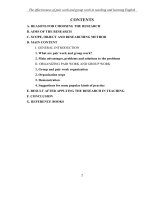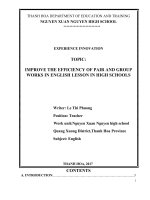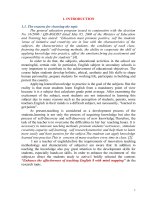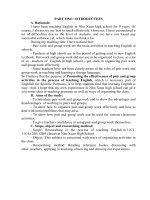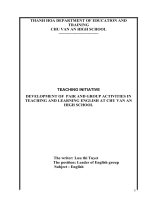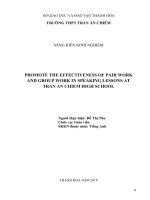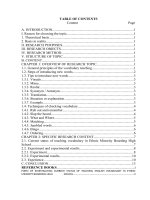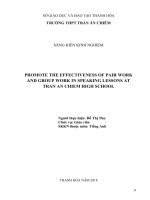Promoting the effectiveness of pair and group activities in the process of teaching english
Bạn đang xem bản rút gọn của tài liệu. Xem và tải ngay bản đầy đủ của tài liệu tại đây (265.13 KB, 21 trang )
PART ONE: INTRODUCTION
A. Rationale:
I have been teaching English in Nhu Xuan high school for 9 years. Of
course, I always try my best to teach effectively. However, I have encountered a
lot of difficulties due to the level of students, and we have not found any
successful sollution yet, which make me think a lot.
During my teaching time I have noticed that:
- Pair work and group work are the main activities in teaching English at
schools.
- Teachers at high shools are in the period of getting used to new English
textbook. Pair work and group work did not use to be organized in class, so a lot
of us –teachers of English at high school – get stuck in organizing pair work
and group work effectively.
- Some teachers have not been clearly aware of the roles of pair work and
group work in teaching and learning a foreign language.
So I believe that the purpose of Promoting the effectiveness of pair and group
activities in the process of teaching English, which is necessary part of
Enghlish for Specific Purposes, is to help students find that learning English is
easy. And, I hope that my own experiences in Nhu Xuan high school can give
you some ideas in teaching grammar as well as ways of organizing the class.
B. Aims of the study:
- To introduce pair work and group work and to show the advantages and
disadvantages of working in pairs and groups.
- To show how to organize pair and group work effectively and how to
deal with initial problems that may arise.
- To show how pair and group work can be used for various classroom
activities.
- To give teachers confidence in using pair and group work themselves.
C. Scope, object and researching method:
- Scope: Researching in the process of teaching English at 11C1,
11C4,12B5,12B6 classes at Nhu Xuan High School
- Object: This subject is concerned with ways of organizing activities in
the class.
- Researching method: Reading reference books, discussing with
other teachers, applying in teaching, observing and drawing out experiences.
PART TWO: DEVELOPMENT
I. GENERAL INTRODUCTION
1. What are pair work and group work?
1.1 Pair work:
Pair work is learners working together in pairs. One of the main
motivations to encourage pair work in the English language classroom is to
increase the opportunities for learners to use English in the class. Example. The
learners are answering comprehension questions in pairs after reading a text.
1.2 Group work:
Group work involves students working collaboratively on set tasks, in or
out of the classroom. Group work includes:
- any learning and teaching tasks or activities that require students to
work in groups
- any formal assessment tasks that require students to work in groups.
Group sizes can vary from pairs to large groups of students. This guide
deals with small groups (pairs and small teams of three to six). While the focus
is on the face-to-face environment, much of the content also applies to larger
groups or the online context.
2. Main advantages, disadvantages and tips to improve working in a
pair or group:
For certain types of activity, pairwork and groupwork have number of
advantages over working with the whole class together. Teachers should
think what the main advantages are, and also what problems might be involved
in pairwork, groupwork and the solutions for these.
Here are some main advantages and disadvantages:
Advantages and Disadvantages of working in a pair or a group:
Advantages of Working in a Pair and a Disadvantages of Working
Group
in a Pair and a Group
More Productive
Unequal Participation
More Resources
Intrinsic Conflict
More Reliable
No Individual thinking
Learn Things
Decision making takes time
New Method
Easy to avoid work
Information Exchange
Loss of Creativity
Team Commitment
Time Consuming
2.1: Advantages of working in a pair or a group:
One might opt to work in a group and a pair, due to many reasons. What
one needs to see is what works best for the lesson as well as the person.
So if you are confused on why work in groups or positives or advantages of
teamwork then here are some points on the positives and advantages of working
in a group.
*. More Productive:
It is been found that one of the main benefits of working in a group is that
it helps to raise the complete output.
If working in a group, everyone works together making use of the best of
their skills to make sure of quality output.
It will also guarantee that there has not been any compromise on the
quality of the production, whilst working as a team. This is one of the best
benefits of team working.
*. More Resources:
One thing to realize is that more the number of people that joins the
group, the resources also increase alongside it. This is one of the pros of
teamwork.
For example, as more people are added, the total ability of the person also
increases. Other than the skills, the experience of each new person is as well
added to the group.
If the person is working individually, he will not have the support from
the other people in the group.
*. More Reliable:
One good thing about working in groups is that if in case someone is not
keeping well or if they miss the work for some reason, the job can still be done
properly and efficiently by the rest of the people in the team.
Since working in a group there are people who are aware of what’s
happening at work. This is not possible if a person is working alone or
individually.
If one works in a group, they can also ensure that the ideas or suggestions,
which are not at par, are rejected at the very beginning. This is one of the
benefits of group work.
*. Learn Things:
It is seen that more often that, people in a group can go on to learn new
things from the others. They get the option to learn from each other.
All people while working in groups have their own ideas, from which
another person can learn so many things.
On the other hand, when one is working individually, they have to do
things on their own. You do not have the time to learn anything from anyone
else. Learning new things is one of the benefits of group work.
*. New Method:
When working in a pair, a group, each one gets the opportunity to come
out with their own ideas and suggestions, thus paving way for new methods on
how to complete the job, properly.
Each one can work towards the success of the work. Since it is a large
group, there could be quite a few of the suggestions or ideas by some of the
people that are innovative and novel, which could help the job to complete
successfully
*. Information Exchange:
While working in a pair, a group, everyone gets the opportunity to
communicate with others well within the pair and the group.
Each idea or suggestions, whoever it is by is considered and thoroughly
discussed before the group arrives at a conclusion.
Hence, we can find that the flow of conversation or communication is
smooth and effortless within the people of the pair, the group. This contributes a
lot to the success of the lesson, given. This can also be called as group
discussion.
*. Team Commitment:
When one is committed to working in a team, the person can go on to
encourage and support the performance as a group.
A person, totally dedicated to the job at hand and to the team, will also
make sure to be present to do the job. This is known as total team commitment.
2.2: Disadvantages of Working in a pair or a group:
At the same time, working in groups is not without its disadvantages. It
may not work out for the best, all the time.
Trying to get our students in a pair, a group to work together is very
strenuous and also takes up a lot of time.
At the same time, if students come together to work towards the success,
there is nothing better than that. Here are some negative points of working in a
pair, a group or disadvantages for pair, group work.
*. Unequal Participation:
It is quite possible that while in a pair, a group some of the students may
not do that much work, while others may work hard. This inequality in the work
done could cause trouble between the people in the group.
It also causes bitterness amongst the members of the group, because some
may be getting acknowledged for a work that they have not even done, at all,
while others may have strived hard to get that honor. Jealousy, in such a
scenario, is without a doubt inevitable.
*. Intrinsic Conflict:
When a wide variety of students start to study in a pair, a group,
disagreement is sure to arise between all the students in the pair and group.
Each pupil may have their own ideas which could conflict with what the
other person has to suggest. Some students in a pair, group might also find it
difficult to accept suggestions or ideas from another person. This conflict could
as well put a stop to the flow of work until the issue is resolved.
*. No Individual thinking:
While working in a pair, a group, there is no place for individual
or independent thinking. It is by no means as one man show.
It is more of a pair, a group effort to complete a job properly. Each idea
and suggestions put forward by all the members of the group have to be taken
into account for successful completion of the work.
*. Decision making takes time:
In view of the fact that it is a pair, a group effort, suggestions and ideas
from all the people in a group have to be taken into account.
Prior to making any decision, all aspects are to be thoroughly discussed and
considered, which consequently takes up a lot of time and energy.
*. Easy to avoid work:
When in a pair or a group especially a large one, it is very easy for the
person to avoid work and leave it to others to complete. It may take some time
before someone actually pays attention to this fact.
One can work, in whatever way possible and can also get
acknowledgment for work done by someone else, as it is teamwork and the
person is part of the team.
*. Loss of Creativity:
Whenever you need to work as a pair or a group, the group or a pair
thinking becomes more relevant. Because of this reason, the creativity has been
stumped.
One can never make a good decision, as each and every person of the
group will have a say in it.
*. Time Consuming:
The whole process could be time-consuming while working in a pair or a
group. It takes a lot of time since there is the need for agreement and
coordination from all members of the team.
*. Inequality in getting work:
If the person opts to work in a pair or a group, when the work is being
distributed chance is not everyone gets an equal amount of work.
Some one might end up with more work, while other might get only little to do.
This discrepancy in getting the work can also lead to conflict.
*. People might loaf around:
One other issue while working in a group, is that some of the people may
just hang around, gossiping or loafing around without doing the work. This
could result in lesser productivity from their end.
2.3: Tips to improve working in a pair or a group:
To make the students understand more about the lectures I want to metion
some tips:
It is often found that students working in a pair or group can work better
when they are comfortable with each other.
Engaging in social activities together can help one to overcome this
problem.
Once, the role to be assumed by all is clearly marked out it becomes easier
to work in a pair or group.
The students need to have a proper ongoing exchange of ideas.
In Order to get the best of output, one needs to focus more on the benefits
of working in a pair or group.
Thus, working together can prove to be advantageous for the lesson, as well as
the job.
3. Major issues of the English teaching:
Nhu Xuan district is a mountainous area. It is considered a poor district.
As the school has 1250 students, but the quality is not very high.
Teachers used simple method, and did not know how to organize the
whole class in learning Enghlish effectively.
Results before using games in teaching
School year: 2017- 2018
Good
Number
Class
of
Amoun (%
students
t
)
10C1
40
0
0.0
10C4
38
0
0.0
11B5
38
0
0.0
11B6
35
0
0.0
Rather
Amoun
(%)
t
20.
8
0
23.
9
7
26.
10
3
34.
12
3
Average
Amoun
(%)
t
55.
22
0
63.
24
2
57.
22
9
54.
19
3
Weak
Amoun
(%)
t
10
25.0
5
13.2
6
15.8
5
14.3
You can see the above table, good students accounted for zero percent for
four classes in term of being interested in learning English, the weak students
accounted for high percent ( from 13 to 25).
II. ORGANIZING PAIR WORK AND GROUP WORK
1. Group and pair work depends on some extents:
- The success of group or pair work depends on some extents:
The surrounding social climate.
How habituated the class is to using it
The selection of an interesting and stimulating task whose
performance is well within the ability of the group or pair.
- More immediately, it also depends on:
Effective and careful organization.
2. Organization steps:
2.1.Presentation:
The instructions that are given at the beginning are crucial. If the
students do not understand exactly what they have to do, therewill be timewasting, confusion,lack of effective practice, possible loss of control. Select
tasks that are simple enough to describe easily; and in monolingual
classes, you may find it cost- effective to explain some or all in the
students’mother tongue. It is advisable to give the instructions before giving out
materials of dividing the class into groups; and a preliminary rehearsal or “ dry
run” of a sample of the activity with the full class can help to clarify things. If
your students have already done similar activities, you will be able to
shorten the process, giving only brief guidelines; It is mainly the first time of
doing something with a class that such care needs to be invested in instructing.
Try to foresee what language will be needed, and have a preliminary
quick review of appropriate grammar or vocabulary. Finally before giving
the sign to start tell the class what the arrangements are for stopping: If there
is a time limit, or a set signal for stopping, say what it is; if the groups simply
stop when they have finished, then tell them what they will have to do next.
It is wise to have a reserve task planned to occupy members of groups
who finish earlier than expected.
2.2. Process:
Teacher goes from group to group, pair to pair, monitor, and either
contribute or keep out of the way whichever is likely to be more helpful. If you
do decide to intervene, your contribution may take the form of:
- Providing general approval and support;
- Helping students who are having difficultly;
- Keeping the students using the target language (in many cases your
mere presence will ensure this!)
- Tactfully regulating participation in a discussion where you find
some students are over dominant and others silent.
2.3.Activities which lend themselves to pair work and group work:
2.3.1 Activities which lend themselves to pair work
*Roll the ball
This can be used to practise any language that requires a question/answer
pattern. They can roll the ball to each other and have to say the appropriate
sentence as they roll the ball. E.g. 'Hello.' 'Hello.' 'What’s your name?' etc.
Remember the sentences they practise should be fairly short.
*I nformation gap
Give each pair a picture. The pictures should be nearly the same with two
or three elements missing from each picture. Without showing each other the
pictures they should describe the missing objects. They will practise colour,
prepositions of place, and adjectives such as big, small, etc. Then they can
compare their pictures.
*Telephone conversations
Sitting back to back they can practise telephone language or just simple
exchanges that don’t have to be connected to the telephone itself. Sitting back to
back should arouse their interest and help train them with listening skills. It’s a
challenge, but a fun one!
2.3.2 Activities which lend themselves to group work
*Posters
Used to practise categorizing skills, reviewing colours and names of toys.
The children can be in charge of finding pictures of toys and grouping in
terms of colour or type of toy and displaying their work.
* Cuisenaire rods
If you can find a set of these wooden, colour coded rods you’ll find they
come in handy for a whole host of activities. Give a random selection to the
small groups. Together they must imagine a scene and build it to then describe to
the class.
*Weather dressing
Bring in a selection of items of clothing. You can ask the children to bring
in one item each the week before but bring a few extra yourself to account for
those who forget. Put the items in four piles around the room to make access
easier and to avoid a scramble on one pile. The class should be in four groups –
one for each season. They have a few minutes to collect a certain number of
items that they could wear in that season. Everyone must have at least one item.
But no-one in the group must have the same item as their other group members.
The language they use can be describing to their group what they’re wearing,
using colours and clothing vocabulary, and saying in what weather conditions
they would wear the item. The other group members can say if they think it’s
appropriate for their season or not.
2.4. Ending:
Draw the activity to a close at a certain point. Try to finish the
activity while the sudents are still enjoying it and interested, or only just
beginning to flag.
2.5. Feedback:
A feedback session usually takes place in the context of full- class
interaction after the end of the group work. Feedback on the tasks may take
many forms:
- Giving the right solution, if there is one.
- Listening to and evaluating suggestions.
- Pooling ideas on the board.
- Displaying the meterials the groups/pairs have produced. And so on.
The main objective here is to express appreciation of the effort that
has been invested and its results. Feedback on language may be integrated into
this discussion of the task, or provide the focus of a separate class session later.
3. Demonstration:
3.1 Example of pair work:
Example :
A teacher has an intermediate class. She presented “like/don‟t like” and
then she uses this exercise for free practice in pairs:
Likes and dislikes
Pairwork: Ask what your friend likes and doesn’t like
Ask about:
Food
Clothes
Sport
School
subjects
Things the teacher did before, during and after the activity.
Before: Teacher says “All right. Exercise 3. Work in pairs; ask and answer
the questions”
During: Teacher sits at one place and says nothing.
After: Teacher says “Everyone finished? Good. Now look at exercise 4...”
- Some questions for us:
Do you think the activity was successful ?
What do you think might have gone wrong ?
What could she do to make it more successful ?
* Discuss why the activity was not successful, and what the teacher could
do to make it more successful:
- She could prepape for the pairwork by establishing what the
questions and answers should be. She could also demonstrate the pairwork
by asking questions round the class, or by getting one pair of students to ask
and answer in front of the class. Then students would know exactly what to do.
- She could be more active in starting the pairwork. Instead of just saying
„work in pairs‟, she could show students who to work with, check that
everyone had started working in pairs. This would be very important if the
class were not used to pairwork.
- During the activity, she could move quickly round the class to check that
students were talking and to see when they finished.
- Instead of waiting for everyone finished, she could stop the
activity. Then there would be no chance for students to get bored and start
talking about other things.
- After the pairwork, she could ask some pairs what they said, or ask a few
pairs to repeat their conversation in front of the class.
3.2. Example of group work.
Task 4 (Unit 5 –Part B: Speaking –English 10) This is a free activity and
aims to develop fluency in speaking. The procedure may be:
Divide student into groups of four or five.
Read through the instructions and make sure that each groupunderstands
what to do. Choose one “secretary” in each group to write the list but emphasis
that everyone in the groups should agree on what to write.While the activity is
going on, move from groups, but do not interrupt more than is necessary.When
some groups have finished their discussion, stop the activity, ask one person
from each group to report on what they decided.
Give feedback:
- Content
- Popular mistakes
3.3. Example of dividing the class:
First, draw a plan of your own class of 4 students. Show how you would
divide the class for a pair work or a group work activity and what instructions
you would give:
Here are two rows of a class of 40 students. The desks are fixed and the
students sit on chairs
1 2
3
9 10
11 12
19
17 18
4
20
5
6
7
8
13
14
15
16
21
22
23
24
25
26
27 28
29
30
31
32
33 34
35 36
37
38
39 40
For pair work:
Most students could work with the person next to them. Student 1 could
turn round and work with student 2 and students 9, 10. Or student 3 could move
to work with student 4, 11,12,2 .
For group work:
Students could work in fours along each row. This would be easy
to organize but would make it difficult for students to work well as a
group, as they would be in a straight line. Or students in the first row could turn
round and form groups with those behind.
The first few times that you try pair or group work, you need to give
careful instructions and know exactly how you will divide the class. Pair work
and group work can become a routine. Once students are used to it and have
regularworking partners, it can be organized quickly and easily.
4. Suggestions for some popular kinds of practive
Pairwork and groupwork are not “teaching methods”, but ways of
organizing the class. They can be used for many different kinds of activity,
and are naturally more suitable for some activities than for others. Before
deciding what kind of activity will be used teacher should answer the following
questions:
- Could you use pairwork on groupwork for part of the activity?
- If so, exactly what would students do in pairs or groups?
- What would you need to do before the pair/ group stage?
- Is there anything you would do after it?
Here are suggestions for some popular kinds of practice
* Pattern practice:
This can be done in the same way as practicing structure with “used to”
mentioned in part 2 – Demonstration. Any controlled oral practice can be done
first with the whole class, and then in pairs.
* Practising short dialogues:
Acting out short dialogues can be very easily be done in pairs, with little
chance of making mistakes. It can be done first with pairs of students in front of
the class and then with all students working in pairs at the same time.
* Reading a text and answering questions:
Students can disscuss questions in pairs or groups and then read the text
or they can read the text silently and then ask and answer questions in pairs or
groups. This is a good way of involving the whole class in answering questions.
* Short
- Writing exercises:
Student can sit in groups and decide together what to write. One
student acts as “secretary”. This can be difficult to organise but in a large class
it has the advantages that students correct each others,mistakes and the teacher
only has a few papers to mark at the end.
Pair work can be used for correcting written work (eg:homework)
- Students sit in pairs and correct what their partner has written.
* Discussions:
With more advanced class, discussions can be conducted in group. It is
important to define the discussion clearly and to ask each group to report their
conclusions afterwards.
*Grammar exercises:
Student can do grammar exercises orally in pairs; the teacher goes
throught the answers afterwards with the whole class and students write the
exercises for homework.
This is more interesting and productive than students doing exercises
alone, in silence.
D. APPLYING THE RESEARCH IN TEACHING
Unit 12: the Asian games
The 77th period
Grade 11
Unit 12: Speaking
I. Objectives:
1. Educational aim: Students could talk about sports results
2. Knowledge:
- General knowledge: - Through this unit, students can ask and answer
about the Asian Games and sports
- Language: Ask and answer questions about the Asian Games and sports
3. Skills: Fluency in expressing opinion and expressions about the Asian
Games and sports in Vietnam
II. Method: Integrated, mainly communicative
III. Teaching aids: Pictures, English textbook 11, hand-outs
IV. Procedures:
Teacher’s activities
Student’s activities
Warm-up:(6 munites)
- Ask students close the book and - Listen to the teacher
arrange these jumbled words to make - Find out the words
the complete questions by putting the - Suggested answer:
words given in the right orders
1. When and where were the 14th- Asian
- 1. were, the ,where, Asian, held, Games held?
games, when, and ,14th- ?
2. How many countries took part in the
- 2. countries , in how , the part, many, games?
took, Games ?
Today, we will practice speaking
about the Asian Games
Pre-reading: (5 minutes)
Task 1:
- Ask students to read the dialogue
and ask them what points are
mentioned in the dialogue
- Ask student to work individually
then work in groups
- Call on some pairs to act out the
dialogue
- Give suggestions
While –speaking :(24 minutes)
Task 2:
- Ask students to look at the pictures
and talk turns to talk about the sports
results of the Vietnamese athletes at
14 asian games ,using the information
from the table below
- Ask students to work individually
then in pairs
- Walk around the class to help student
when necessary
- Check and give suggestions
- Ask student to practice it with a
partner
- Corrects students’ pronunciation if
necessary
Post-reading: (13 minutes):
- Ask students to talk about the Asian
games and sports in which Vietnamese
athletes took part in
- Give the meaning of some words
when necessary
- Ask students to work individually
then work in pairs
- Walk around the class to help
students when necessary
- Check and give suggestions
- Ask students to practice this
conversation
- Correct their pronunciation when
necessary
- Give comments
Homework(2 minutes):
- Read individually and then work in
pairs
- Listen to the friend and give comments
-Listen to the teacher
Compare the answer with the partners
Ask the teacher if necessary
-Some groups present their answer in
front of the class
-Answer :
1,in bodybuilding, the Vietnamese
athletes won one gold medal and one
bronze medal
………….
- Do the task
- Compare the answer with the partners
- Work in groups
- Ask the teacher if necessary
- Some groups present their answer in
front of the class
- Copy in their notebooks
-Write about the Asian games their - Take notes
like and prepare the next lesson
Unit 15: space conquest
The 94th period
Grade 11
Unit 15: Writing
I. Objectives:
1. Educational aim: By the end of this lesson, Students can get to know
the content and structure of one’s person biography.
Students can write the biography of one identified person, based on the
given information.
2. Knowledge:
General knowledge: Students learn about the content and structure of a
biography of a person.
- Language: The Simple Past Tense and Simple Present Tense
3. Skills: Writing a biography
II. Method: Interagrated, mainly communicative
III. Teaching aids: Chalk, textbook
IV. Procedures:
Teacher’s activities
Students’ activities
Warm up(3 minutes)
*Show a short video clip /picture *Work in pairs
about Neil Armstrong and ask *Suggested answers:
students some questions about
- He is Neil Armstrong
him:
- He is an astronaut
- Who is he?
- He is American
- What does he do?
- In 1969
- Is he Russian or American?
- When did he walk on the
moon?
- Ask students to work in pairs to
answer
Pre -writing (12 minutes)
- Divide sts into four groups, ask
one from each group to the - Work in groups
board to write down information - Brainstorming for needed words/phrases to
we need to write one’s write one’s biography
biography. Others in the same - Suggested answers: job, address,
group can help by shouting the hometown, career, place of birth, date of
needed words or phrases.
birth, quote, marital status, family,
- Give feedback and marks to the education…
group with correct information.
- Choose five words/phrases and
explain the meanings (if
necessary): career, place of birth,
date of birth, quote,
Whilewriting(20minutes)
Task 1:
-Ask sts to read the information
about Neil Armstrong, the first
human to set foot on the moon,
then put each of the headings in
the box in the appropriate blank.
- Show some pictures relating to
the career of Neil Armstrong:
NASA, the moon, space shuttle,
United States Navy.
- Explain the meaning of some
difficult words: resign, appoint,
vice
chairman,
committee,
investigate, disaster, leap)
Task 2:
- Teacher divides students into
groups of four.
- Asks sts to write a biography
of Neil Armstrong from the
information given in task 1
- Ask sts to pay attention to these
points:
+ Prepositions: at-on-in-from-towith
+
Articles:
a-an-the
+ Words/phrases used to write
biography: be known as- work
asresign
from+
Simple
past
tense
+Simple present tense
- Move around to supervise
and give help when
necessary
- Work individually, then check with their
partners.
- Take notes on difficult words.
- Suggested answers:
1. Birth
2. Place of Birth
3. Known as
4. Career
5. Quote
- Students works in groups and write the
biography on a piece of paper card
- Suggested answers:
Neil Armstrong is an American astronaut. He
is known as the first person to walk on the
moon. He was born on August 5th, 1930 in
Wapakoneta in Ohio. From 1949 to 1952, he
worked as a pilot in the United States Navy.
Armstrong received his B.S from Purdue
University in 1955. He joined the NASA
astronaut program in 1962. Neil Armstrong
became the first human to step on the moon’s
surface on July 20th, 1969. He was joined by
Buzz Aldrin forty minutes later. Armstrong
and Aldrin spent two and a haft hour on the
moon’s surface. Armstrong received his M.S
from the University of Southern California.
He resigned from NASA a year later and
from 1971 to 1979, he taught at the
University of Cincinnati. In 1986 Armstrong
was appointed vice chairman of the
committee that investigated the Challenger
shuttle disaster. He is also well-known for
Post writing (10 minutes)
what he said when he stepped on the moon’s
- Ask sts to exchange their paper surface:” That’s one small step for man, one
card to correct
giant leap for mankind”
- Ask one group to show their
biography on the board.
- Students pick out the mistakes then correct
- Give comment and correct in them.
front of other students, ask them - show their biography on the board
to pay attention to some basic
grammatical mistakes
Homework
- Write their own biography at home
- Ask sts to write their own
biography at home
Unit 12: WATER SPORT
Period 70
Grade 12
LESSON 1: READING
I. Objectives
1. Educational aim: Through the lesson Sts will be able to know more
about sports, water polo.
2. Knowledge:
- General knowledge: Sport
- Language: + New words. Words related to water polo such as
opponent, penalize, eject, foul, tie.
+ Grammar.
3. Skills: + Read and guess the meaning of the words.
+ Read and find the characters of water polo.
+ Read and answer the questions.
II. Methods: - Individual, pair work, group work.
III. Teaching aids: - Textbooks, pictures in the book, posters.
IV. Anticipated problems: Sts may get trouble in understanding some
new words.
V. Procedures:
Teacher’s activities
Students’ activities
1. Warm up: 5’
Using the picture of the book
Whole class
- Teacher asks Sts some questions:
Sts look at the picture and answer
the questions
Can you name the sport in the picture?
water polo
Where is it played?
in a pool
How many people play it?
seven players
How do people play it?
- Teacher corrects mistakes and
- Lead in the new lesson.
2. Pre-reading: 10’
* Pre- teach Vocabulary.
- vertical sport(n).
- crossbar(n)
- advance (v) = more forward
- interfere with Sth (v)
- punch (v)
- Rub-out and remember
- T: Feedback
*True – False prediction ( handout)
- T: asks Sts to work in group to predict these
sentences are True or False.
a. Water polo is played in a pool 1.8 metres
and 3.5 metres.
b. players can hold the ball with both hands.
c. A game is divided into four ranging.
d. A player is ejected after commiting five
personal fouls.
- Collects groups’ opinions
Real aloud
Individual work
3. While-reading : 10’
1. T/ F correction :
Group work
Sts go to board and write
Group work ( 4 groups)
- Asks STs to read the passage and correct T/F
prediction and give in evidences.
Sentence
s
a
b
c
d
predic
t
T/ F
T/ F
T/ F
T/ F
correc
t
F
F
T
T
evidences
30 m long
No
player,
except
the
goalie.
Work in individual
(1). 18m; (2). 30m; (3). 20m
2. Task 2 : 10’
Complete the flollwing sentences, using the (1). White caps; (2). Blue caps;(3).
Red caps.
information from the passage
1. Water polo is played in a pool (1). Their own goalies
(1) .................metres deep, (2).................long (1). Holding or punching the ball
(1). Five to light minutes
and (3).................wide.
2. The home team wears (1)..............., the
visiting team wears(2).............and the goalies
wear(3).......
3. Both team sprints for the ball from
(1)..............
4. a free throw is awarded for minor fouls, Group work
such as (1).....................
Individual work
5. A game is divided into quarters ranging
from (1)......................in length
- Teacher gets feedback.
Whole class
4. Post- reading: Discussion: 7’
- Ss work in groups to scan the reading again
to find a suitable sentence for each paragraph
5. Homework: 2’
- Learn vocabulary by heart.
- Do exercise 1 and 2 again.
E. Compared to the amount of the initial survey:
Result before applying games to teach
School year: 2017- 2018
Cla Number Good
Rather
Average
ss
of
Amoun (% Amoun (%) Amoun (%)
students t
)
t
t
10C1 40
0
0.0 8
20. 22
55.
0
0
10C4 38
0
0.0 9
23. 24
63.
7
2
11B5 38
0
0.0 10
26. 22
57.
3
9
11B6 35
0
0.0 12
34. 19
54.
3
3
Results after applying the research in teaching
School year: 2018- 2019
Cla Number Good
Rather
Average
ss
of
Amoun (%) Amoun (%) Amoun (%)
students t
t
t
11C1 40
4
10.0 14
35. 20
50.
0
0
11C4 38
1
2.6 10
26. 26
68.
3
4
12B5 38
4
10.5 16
42. 27
71.
1
1
12B6 35
2
5.7 20
57. 15
42.
1
9
Weak
Amoun
t
10
(%)
25.0
5
13.2
6
15.8
5
14.3
Weak
Amoun
t
2
(%
)
5.0
1
2.6
1
2.6
0
0.0
The above tables disclosed that the good students accounted 0 percent
after applying the research in teaching helps students interested in increased 1%
to 4%, rather students accounted from 8-12 percent increased 10-20 percent and
bad students decreased just 1 -2%.
PART THREE: CONCLUSION
I. IMPLICATIONS FOR MORE EFFECTIVE :
1. To the teachers
Choosing techniques is the day – to – day business of every English
teacher. Organizing activities play a very important role in lessons because if the
teacher conducts this stage successfully, the classroom atmosphere will change
and also the students’ performance will be much better. Therefore, the teacher
should make sure that the following things are done perfectly.
First of all, preparation is necessary for English teacher with a list in
details of activities prepared with useful language knowledge, good time
management for each activity, effective visual aids usages and clear instructions
giving. One more thing is that the teacher should know how to motivate the
students by changing the activities day by day or take care of the quiet students
in the class by using different activities in teaching
2. To the classroom facilities
In Vietnam, it is normal that there are 40 to 50 students in a language
classroom at high school. This makes the teachers meet many difficulties in
conducting a language lesson. However, the situation can not be changed in a
short period of time so the teacher should get over all these difficulties by
making sure that the classroom facilities are comfortable enough before the
lessons
II. LIMITATIONS AND SUGGESTIONS FOR FURTHER
RESEARCH
The study still has some limitations. First of all, this study is very small –
scale, which focuses on Promoting the activities of pair work and group work
effectively in the process of teaching . Secondly, the study basically bases on
one source of data, questionnaires, which might be subjective on the side of the
informants, so the researcher can not guarantee the reliability of the information
collected.
III. CONCLUSION
In group or pair work, learners from a learning task through
small group interaction. Learners in a class that is divided into six groups or 15
pairs get six times or fifteen times as many opportunities to talk as in full
class organization. They also have other advantages: They foster learner
responsibility and independence, can improve motivation and contribute to
a feeling of cooperation and warmth on the class, so that organizing pair
work and group work effectively helps improves learning outcomes.
Thanh Hóa, ngày 10 tháng 5 năm2019
XÁC NHẬN CỦA THỦ TRƯỞNG
Tôi xin cam đoan đây là SKKN của
ĐƠN VỊ
mình viết, không sao chép nội dung
của người khác
LÊ THỊ THƯƠNG
REFERENCES
1.
2.
3.
4.
5.
Michel Maginn: Thúc đẩy làm việc nhóm hiệu quả, NXB Thành
phố Hồ Chí Minh, 2007
According to Jo Betrand: The advangtages and disadvantages of
pair work and group work
Internet sources.
Oxford Dictionary.
Pairwork and Groupwork
Multi-level Photocopiable Activities for Teenagers
AUTHORS
Meredith Levy, Nicholas Murgatroyd
DANH MỤC CÁC ĐỀ SKKN MÀ TÁC GIẢ ĐÃ ĐƯỢC HỘI ĐỒNG
CẤP GD&ĐT ĐÁNH GIÁ ĐẠT TỪ LOẠI C TRỞ LÊN
STT
1
TÊN SÁNG KIẾN
XẾP
LOẠI
Using games in teaching warm – up
B
activities for non – major
English students to improve their
English language
NĂM CÔNG NHẬN
2017
